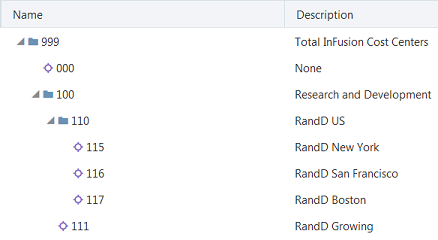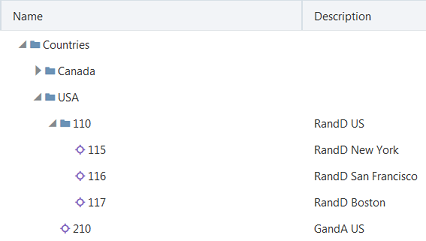Alternate Viewpoints Using Different Top Nodes
You can create an alternate viewpoint in which lower-level nodes are grouped under different top nodes than the primary viewpoint's top nodes but that also preserve the lower-level nodes' parent-child relationships.
For example, let's say there is a hierarchy of cost centers that includes a node named 110 with child nodes named 115, 116, and 117. The 110 node and its child nodes can be placed under a different top node in an alternate viewpoint than in the primary viewpoint.
This type of alternate viewpoint must include the hierarchy that is in the primary viewpoint's data chain. That hierarchy set must allow shared nodes, see Understanding Shared Nodes.
To create this type of alternate viewpoint in a new viewpoint, take the following steps. For more information, see, Defining Alternate Views and Viewpoints.
- Create a new node set using the same hierarchy set used for the primary viewpoint.
- Create the alternate viewpoint using the node set you just created.
Note:
If you prefer, you can instead use the primary viewpoint to group nodes under different top nodes. To do so, you would add new top nodes and then insert the lower-level nodes.Example 21-1 Group Nodes Under Top Nodes for Countries
Suppose there is a primary viewpoint in which cost centers are grouped by lines of business. The lines of business include cost centers for research and development in the United States. The hierarchy of United States cost centers in the following example has a parent node named 110 with child nodes named 115, 116, and 117:

Now suppose you need to create an alternate viewpoint that groups cost centers by the countries in which they are located. In the following example, the alternate viewpoint's top node is Countries, which includes a node for the USA. In the following example, the USA node includes the hierarchy of United States research and development cost centers:
